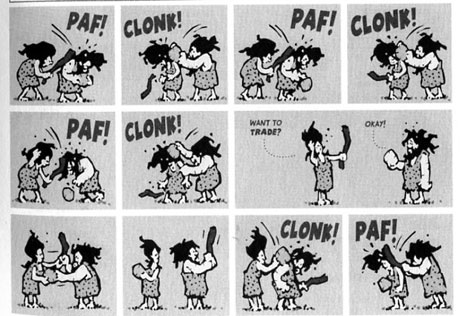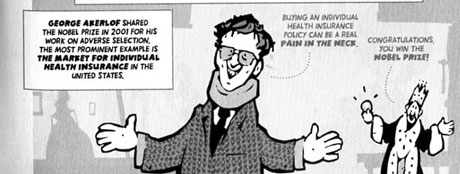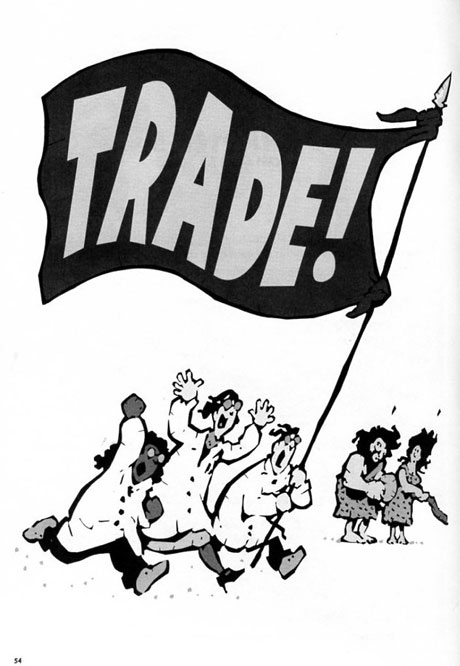The Cartoon Introduction to Economics, Volume 1: Microeconomics
Grady Klein and Yoram Bauman; Hill and Wang; ,224 pp., $17.95; B&W, Softcover; ISBN:978-0809094813
“…nobody, except under threat of torture, can read a school book,” George Bernard Shaw commented. “The reason is that a school book is not a work of art.”
Comics were for many years not considered art either … but in general because they were too easy to read, not too hard. Historically, comics have been sneered at for their excessive accessibility — a trait which makes it difficult (though as recent art-comix trends show, not impossible) for them to attain the rarefied level of obfuscation required for highbrow modernist cred.
The same qualities which doomed them to generations of academic disdain, however, make comics perfect for conveying basic information without sending long-suffering students into a stupor. Scott McCloud figured this out years ago, with the result that, despite their pedestrian insights and hideous design, his books have become staples in introductory college courses nationwide.
Artist Grady Klein and economist Yoram Bauman have taken McCloud’s insights, applied them to material that is not (unlike McCloud’s) actively idiotic, and come up with a thoroughly readable book that explains microeconomics clearly, and even charmingly. Bauman (who has spent time teaching in high schools as well as colleges) and Klein do an excellent job of using analogies to explain the abstract concepts of economics, whether demonstrating Pareto efficiencies by dividing cake, or illustrating elasticities with the use of a torture rack.
The creators are also, in the best traditions of comics, willing to throw in the odd gratuitous joke for pure amusement value:
And, again as per comics tradition, they even engage in some gentle satire. For example, in a series of running gags, the creators cheerfully suggest that a fair bit of economics is simply coating the obvious with a patina of scientific pretension.
But though the book is enjoyable to page through, it’s not exactly a delight to look at. Klein is a better illustrator than Scott McCloud, but that doesn’t mean his drawing is attractive. His characters have a thick, generic, formless quality that suggests clip art, and his layout and design skills are solidly so-so. It’s easy enough to figure out where your eyes are supposed to go on the page, but that’s the most you can say for the layout. His occasional full-page splashes are notable mainly for their lameness; this, for example, is an impressively ineffective use of white space:
Bauman too, has his limitations. While he’s willing to poke fun at economists on occasion, his skepticism has definite limits. There’s no sense in his work of the contested historical or cultural place of economics as a discipline. Thus, the Nobel Prize is mentioned, but not the fact that there is, in fact, no Nobel Prize in economics — the “extra” faux Nobel was added by bankers, because bankers really like economics. Similarly, Fidel Castro and Che Guevara pop up as stereotypical figures of fun, but communism, with it’s generalized assault on the ideological place of economics, is never mentioned.
An economics textbook, of course, is meant to teach you economics; it’s not intended question its own premises. But, whether that’s a failure of Bauman or of the textbook genre, the result is a chirpy platitudinous boosterism, with the last pages of the book assuring the reader that economics can offer “creative and powerful solutions” to problems like climate change.
So is this book a work of art? I would say that it is — though not a great one. Whatever its weaknesses, it was clearly created by particular people to be read by particular other people, rather than, as is the case with most textbooks, created by committee to be read by no one. As a longtime professional educator (God help me), I’d certainly recommend it for high school or first-year college classes, where even mediocre art would be a vast improvement over the general bill of fare.
______________________
This review first ran online at The Comics Journal.




It looks a lot like a watered down version of Larry Gonick. Do you have an opinion about his books, because those are the first good ‘educational’ comic books that spring to my mind.
You know…I haven’t read Larry Gonick. I really should, I know; I’ve seen a bunch of people I respect recommend him. I’ll move it up the list.
I wonder how the book would compare to “A Manga Introduction to the Japanese Economy”:
—————————-
Information manga exploiting the illustrative function of the manga form to serve as study aids for children have existed since before the Second World War. With the extraordinary development of manga as an expressive form during the 1970s, so-called “academic manga” began to appear in general magazines mostly read by businessmen. They do not necessarily have a narrative structure, but the protagonists are shown applying themselves to the study of the origins of and various anecdotes about food, liquor and annual festivals.
It was in this context that A Manga Introduction to the Japanese Economy appeared in 1986. Unlike most manga in Japan, this work was released not in serialization but in book form from the start. Nonetheless, its three volumes sold a million copies, and it was even read by people born before the war. In this way even those who had previously shown no interest in manga and who did not belong to the so-called “manga generation” were compelled to recognize the expressive power of the manga form.
This led to the appearance of ever more manga dealing with subject matter such as history, science, and classical literature…
———————————–
http://www.dnp.co.jp/museum/nmp/nmp_i/articles/manga/manga2-1.html
More about the book: http://www.dnp.co.jp/museum/nmp/nmp_i/articles/manga/manga2-2.html
…Available in the U.S. as “Japan, Inc.: Introduction to Japanese Economics (The Comic Book).” A “Look Inside!” preview at http://www.amazon.com/Japan-Inc-Introduction-Japanese-Economics/dp/0520062892
That Japan Inc book is… a hard read. It’s really really boring. I couldn’t even get close to finishing it.
I think I’ve learnt everything I ever need to know about Japan Inc by reading Jason Thompson’s column.
http://www.animenewsnetwork.com/house-of-1000-manga/2010-10-28
Thanks for the warning!
Aside from some video that you can back up and replay, there’s nothin’ better than comics for clarifying a physical procedure; like these pages of the Will Eisner-prduced M-16* maintenance booklet: http://www.ep.tc/problems/25/02.html , http://www.ep.tc/problems/25/03.html .
(The start of the booklet at http://www.ep.tc/problems/25/ ; the home page of the website, which features other “instructional comics,” at http://www.ep.tc/problems/ .)
The Larry Gonick history books that he both wrote and illustrated are outstanding, exceptionally lively; even if they oversimplify, because comics are less efficient than prose for delivering info (with the exception of the aforementioned “physical procedures”).
Others where other writers have like chipped in (or is it the subjects?) like “The Cartoon Guide to Chemistry/Genetics/Statistics” are much less successful.
I’ve got quite a batch of those types of books — “Marx for Beginners,” (may be read at http://www.scribd.com/doc/28012909/Marx-for-beginners-by-RIUS ), “Postmodernism for Beginners,” “Freud for Beginners,” and ones along that vein, and the farther they get from the illustratable ideal of physical procedures, the less successful they tend to be. What you usually get are cartoons and illos aside a clump of prose; people talking, instead of symbolic visualizations.
As a graphic designer, I’d sure like to see what Scott McCloud’s topnotch ability to come up with memorable, understandable visuals for complex processes or aesthetic approaches ( http://blog.visualmotive.com/wp-content/uploads/2009/12/mccloud-uc-triangle.jpg ) would do with these far more challenging subjects.
“Scott McCloud Draws Google”:
———————–
Google, as part of fanfare for their new open source web browser, Google Chrome, released a comic to explain it, detailing their views on the problems with browsers to date, and their take on solutions. Radly, the comic was made by everyone’s favourite instructional comic maker, Scott McCloud (why are his instructional comics about how to make comics so great, and his actual comics not so?), who reliably manages to distill the complexities of web technology into an easily comprehensible visual form…
————————
From http://www.skynoise.net/category/comics/page/2/ ; the comic at http://www.google.com/googlebooks/chrome/index.html .
* An abysmally finicky, easy-to-jam weapon, that got chosen for ‘Nam because some politico was impressed by a demonstration from the manufacturer.
You definitely should read Gonick. I believe you’ve said you studied as a historian, so this would be especially rich an encounter.
Wasn’t that Crumb ‘Kafka for Beginners’ in that series? Great book.
Speaking of Crumb, here’s an extract from his upcoming TCJ interview:
http://www.tcj.com/tcj-301-excerpt-from-the-genesis-interview/
Mike Hunter will have a fit over this…
Thanks for the tip! A pretty enjoyable interview. Aside from the naiveté of taking Savina Teubal’s assertions (which at least serves to prove that, whatever his personal “issues,” Crumb is hardly against feminism per se, and can be sympathetic to its views), Crumb came across as fairly astute…
And, yes, “Kafka for Beginners” is splendid!
In case no one noticed this bit I’d posted, over in the “Robert Crumb: Survivor” thread:
Speaking of Crumb documentaries…I just checked the offerings at http://www.comicsreporter.com/ , and at June 25, 2011 is the (almost) hour-long “The Confessions Of Robert Crumb”; pretty spiffy!
And, a taste of Gonick:
http://satorismiles.com/wp-content/uploads/2009/06/0905-amber-039.jpg
http://robot6.comicbookresources.com/wp-content/uploads/2009/11/102CHMW2.png
http://images.comicbookresources.com/pd/Cartoon-Vol18.jpg
http://www.larrygonick.com/images/pub/CHMW2/24CHMW2.png
http://pds20.egloos.com/pds/201105/06/83/c0019183_4dc2fcf89673b.jpg
http://pds18.egloos.com/pds/201105/06/83/c0019183_4dc2fd077de0e.jpg
http://2325.ryanhoover.net/wp-content/uploads/2011/02/text.jpg
http://3.bp.blogspot.com/_49i3g77fQB4/S_9ntPylhbI/AAAAAAAAAmM/OAIjGx-VP7U/s1600/first+on+land.jpg
Y una para los que hablan Español: http://griegoantiguo.files.wordpress.com/2009/09/alfabeto-griego.jpg
Gonick interviewed: http://forbiddenplanet.co.uk/blog/2007/cartooning-our-way-through-history-larry-gonick-talks-to-fpi/
Another interview with Gonick:
——————-
Q: What was the toughest era or event to portray? I imagine there were plenty of times where, when faced with a particular event you thought “How am I going to draw that?”
A: No, drawing events is rarely hard. Comics is designed for drawing events. You have characters, setting, and action. It’s making drawings to illustrate abstract ideas that’s hard. My one-page account of Das Kapital, for example. I have to confess that though I think it goes some way towards doing the job, it could be better. Anyway, it was a challenge…
——————–
Th’ whole thing at http://robot6.comicbookresources.com/2009/11/the-end-of-history-an-interview-with-larry-gonick/
Jus’ one more: http://panelsandpixels.blogspot.com/2007/02/graphic-lit-interview-with-larry-gonick.html
(Yes, posting links for me is like stopping after eating one salted peanut…)
Was that caveman cartoon from The Cartoon Introduction to Economics a nod to this Gonick comic — in one of his many foreign translations — http://zulfiifani.files.wordpress.com/2010/06/dua-lelaki-satu-tongkat.jpg ? The crooked stick in “Want to trade?” looks like Gonick’s club…
God that’s an ugly comic. Those pages don’t seem particularly innovative or interesting in their depiction of concepts either. I love the idea, but even without Noah’s opinion I’m put off by this.
I’m just reading McLuhan’s ‘Medium is the Massage’. Now thats an interesting example of visual representation of concept.
I predict Noah will hate the Cartoon History. I like the idea of it, and Gonick is obviously very smart and did a huge amount of research. To some extent, I was even impressed with his ability to make a joke in every single panel. But the jokes just aren’t funny–I think I chuckled at an uncharacteristically dark gag about Spartans molesting boys, but that was it. Everyone else seems to love Gonick, though.
Marshall McLuhan, you don’t know anything about Marshall McLuhan!
——————–
Jack says:
I predict Noah will hate the Cartoon History…
——————–
Well, sure; with his predictable contrarian-ness…
And I appreciated most of Gonick’s gags, as clearly most readers do. Even if they’re not belly-laugh provoking. “The jokes just aren’t funny” statements expand personal reactions into universal truisms.
Yeah, I guess they’re meant to be cute more than funny. And I learned from the book, so I’m glad I read it.
I recently read the first Gonick Cartoon History of the Universe. It was pretty fun (and occasionally funny) and informative. I almost bought the next volume…but then there were other things I wanted to read.